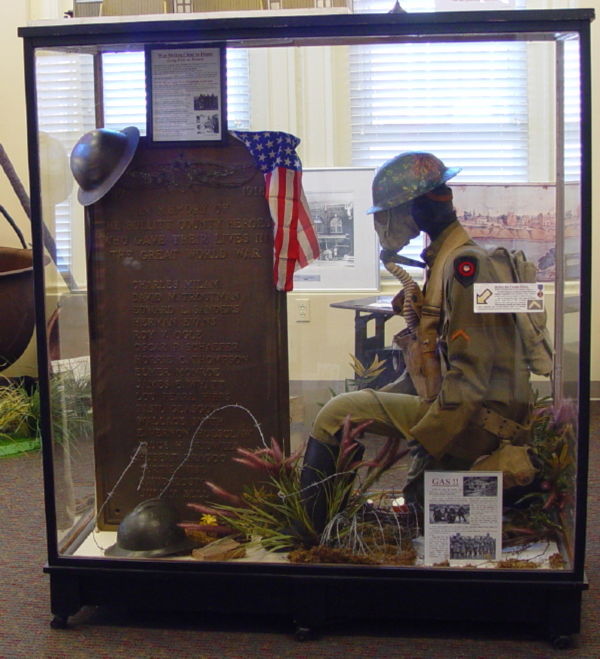
The following article by David Strange appeared in The Courier-Journal on 6 Jul 2014. It is archived here with additional information for your reading enjoyment.
I was talking with someone, recently, about a TV show we had both seen. I mentioned that the story was set in World War One. The person looked confused, and said in all honesty, "World War One? I knew there was a World War Two, but not a One."
Well... Let me just move on with this week's story.
This year, 2014, marks the 100th anniversary of the beginning of what we now call World War I. Of course, the people in 1914-1918 did not call it World War I. In 1914, most did not yet realize the catastrophic human tragedy that was just beginning. None knew of the many horrific wars that were yet to come.
People just came to call their war, "THE World War," or "The Great War."
You are sure to be seeing more about WWI in these coming years of anniversaries. Already, there have been a few shows set during the war, such as Mr. Selfridge and Downton Abbey on Public Television and the movie and play, War Horse. A large part of why these British shows are focusing on WWI is that Europe was already in the war in 1914. The U.S. did not officially enter the war until 1917.
So, very briefly, how did WWI start? There were many causes and tensions, but the trigger was the June 28, 1914, assassination of Archduke Franz Ferdinand of Austria. As a result, Austria declared war on Serbia in July; Russia, an ally of Serbia, mobilized against Austria; which in turn caused Germany to declare war on Russia. Other countries soon joined in, and the whole world began to spiral out of control.
If you know this history and geography, you begin to understand why some people today are nervous about what is going on in Ukraine.

Though the U.S. did not officially enter the war until 1917, nearly everyone was affected.
Like in most wars, it is sad to read the old newspapers when you have the advantage of knowing what is to come. Local newspaper accounts and letters to the editor bluster about how "our boys" will whip "Kaiser Bill," and proudly boast of local boys who have gone off to fight. And then the roll calls of the dead begin to arrive home, and the somber reality of war sets in.
"The Great War" ended the next year, on November 11, 1918. In that short time approximately 120,000 American soldiers died in action or by disease. Over 2400 Kentuckians died. Twenty-one of those were Bullitt County boys. Those 21 were memorialized in a bronze plaque that was mounted on a school gymnasium in Shepherdsville in 1924. That building burned down in 1966, but the plaque, and thus part of the memory, was saved. It hung in the old county courthouse building until that structure was partially razed in 2000. Since that time, the plaque has been preserved and placed in a special WWI display at the Bullitt County History Museum in the county courthouse in Shepherdsville.
And so, a little of the memory and tragedy of a war fought a century ago are saved.
Those Bullitt Countians who died in WWI are:
Julian Bell, David Boston, Bruce H. Bridwell, Hubert Allen Dragoo, Herman Evans, Basil Glasgow, Lou Pearl Hibbs, Everett Vernon Holsclaw, Pvt John W. Lewis, Pvt Charles Milam, Cpl David Millard Troutman, Elmer F Monroe, Cpl Roy V Ogle, Pvt Lilburn Radcliff, Pvt Edward L. Sanders, Sgt Oscar Paul Schaefer, Frank Smith, Sgt Wallace L Smith, Pvt Horrie C Thompson, Pvt Curt T Wise, and James E. Wyatt
Over the next few years we will all be seeing and hearing a lot more about WWI. There will be celebrations of glory, and stories of horror. Hopefully, we will all learn something along the way.
We have related pages, one about the war here and another about Spanish Influenza here.
Copyright 2014 by David Strange, Shepherdsville KY. All rights are reserved. No part of the content of this page may be included in any format in any place without the written permission of the copyright holder.
The Bullitt County History Museum, a service of the Bullitt County Genealogical Society, is located in the county courthouse at 300 South Buckman Street (Highway 61) in Shepherdsville, Kentucky. The museum, along with its research room, is open 10 a.m. to 4 p.m. Monday through Friday. Saturday appointments are available by calling 502-921-0161 during our regular weekday hours. Admission is free. The museum, as part of the Bullitt County Genealogical Society, is a 501(c)3 tax exempt organization and is classified as a 509(a)2 public charity. Contributions and bequests are deductible under section 2055, 2106, or 2522 of the Internal Revenue Code. Page last modified: 12 Sep 2024 . Page URL: bullittcountyhistory.org/memories/ww1.html